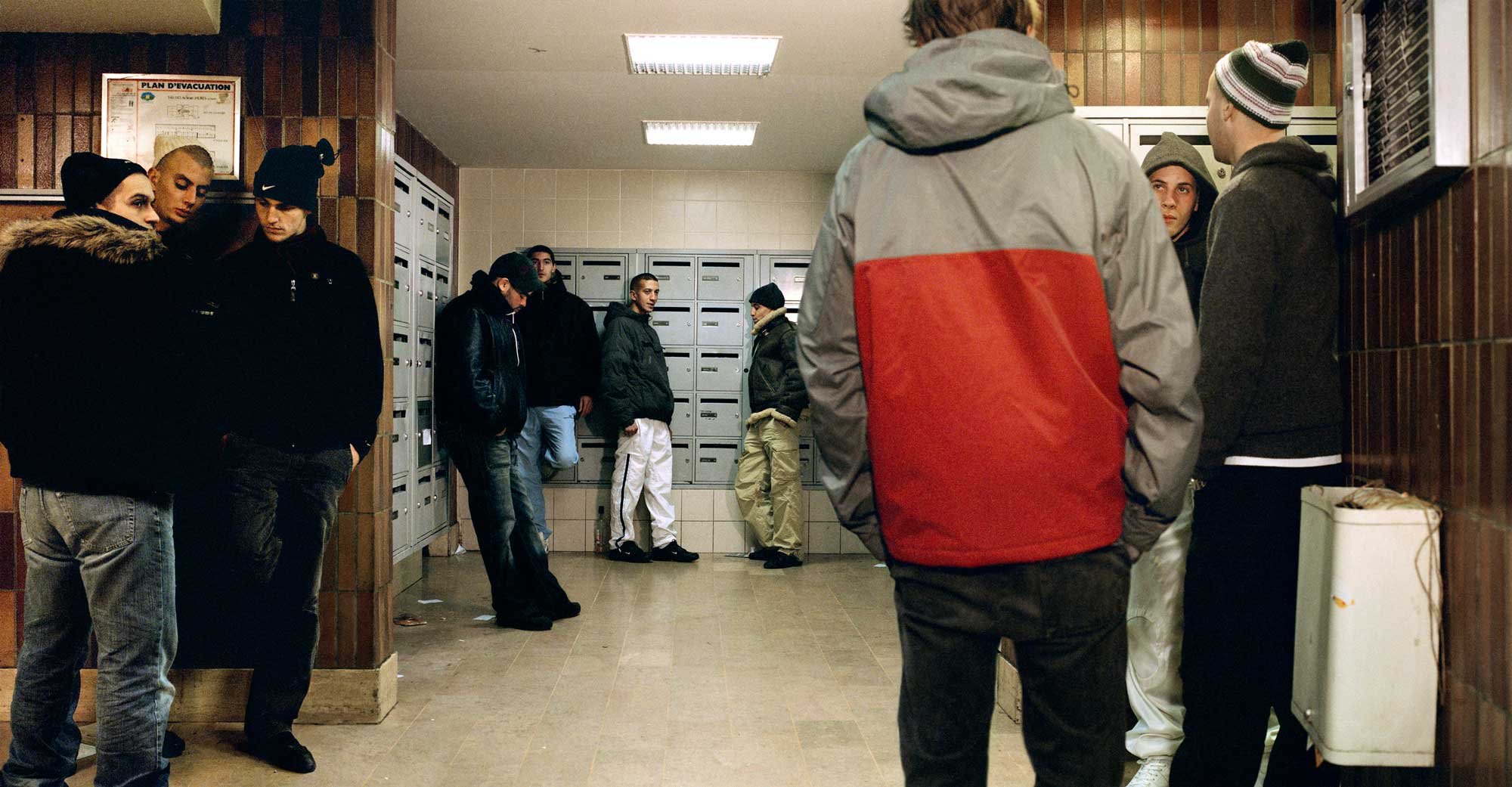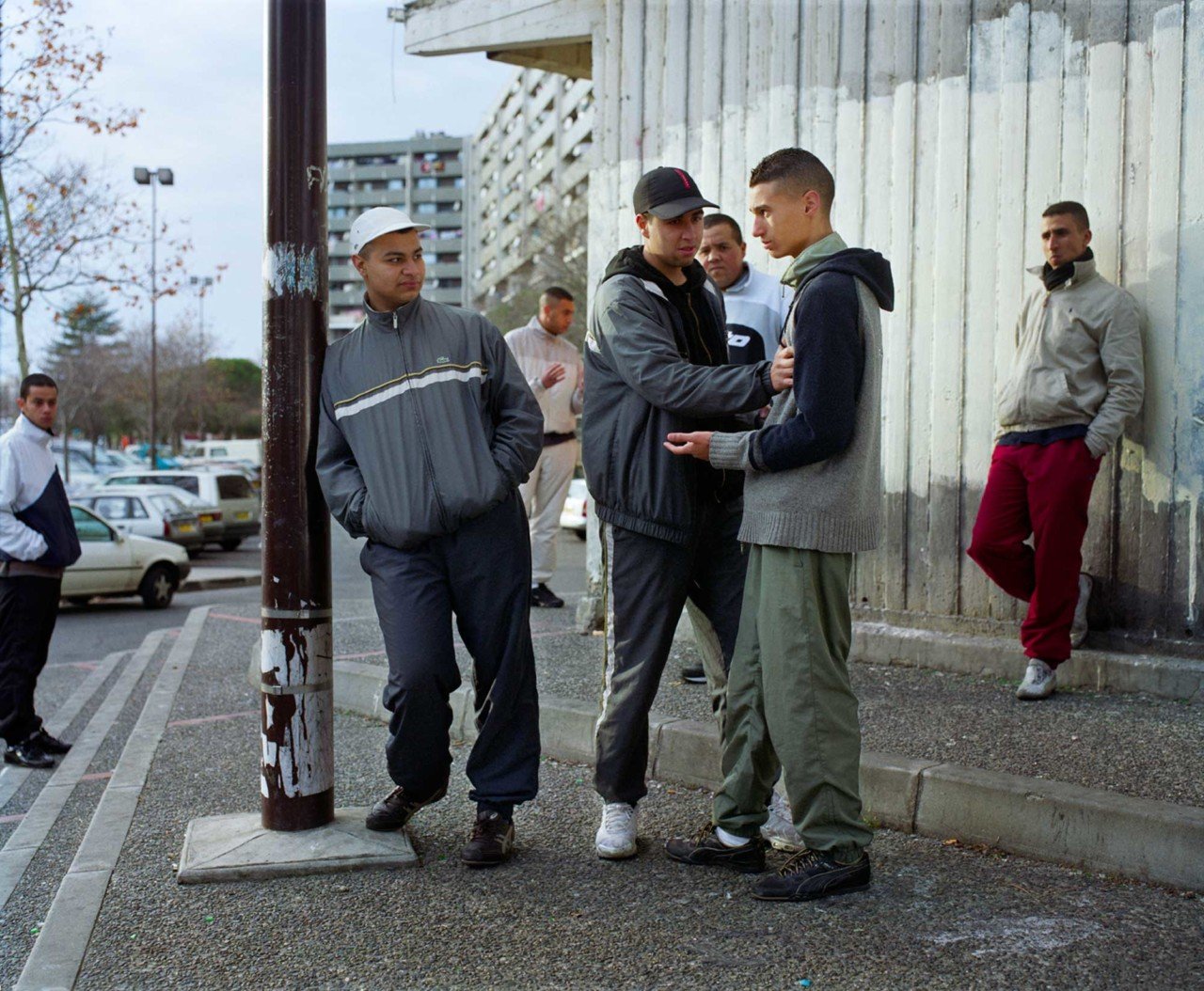Poverty & Police Violence
Still shot of the young protagonists, led by Issa Perica (centre)
Mohamed Bourouissa chose to appropriate the codes of history painting. The artist composed his photos by staging scenes with his friends and acquaintances in the Paris banlieues where they used to hang out. Confrontations, gatherings, incidents, looks, and frozen gestures all suggest a palpably dramatic tension.
Le Groupe, Mohamed Bourouissa, Peripherique, 2005-2008
Bibliography
Behr, E. (1993). The Complete Book of Les Misérables. New York: Arcade.
Gastaut, Y. (2018). ‘«Black, blanc, beur», la fin d’une génération’. Libération. https://www.liberation.fr/debats/2018/07/17/black-blanc-beur-la-fin-d-une-generation_1667033/.
Gilbey, R. (2020). Eye in the sky: how drone technology is transforming film-making. Guardian. https://www.theguardian.com/film/2020/aug/31/how-drone-technology-is-transforming-film-making-french-drama-les-miserables.
Hugo, V. (2015). Les Misérables. London: Penguin.
Jeffries, S. (2020). ‘Ladj Ly on shocking President Macron with his Paris riot film: ‘How could he not know?’’ Guardian. https://www.theguardian.com/film/2020/aug/20/ladj-ly-shocking-president-macron-paris-riot-film-les-miserables-la-haine.
Kermode, M. (2015). Girlhood review – electrifying portrait of a French girl in the hood. Guardian. https://www.theguardian.com/film/2015/may/10/girlhood-gritty-teen-life-review-mark-kermode.
Metropolitan Police Federation (2021). Federation calls on chiefs to end ‘trial by media’ after IOPC verdict. https://metfed.org.uk/34727-2/.
Seigel, M, (2018). Violence Work: State Power and the Limits of Police. Durham, US: Duke University Press
In 1862, Victor Hugo published Les Misérables, an epic novel documenting, amongst other things, the socio-economic conditions in nineteenth century France during the time of the revolutions. Translating verbatim to the poor ones, the miserable ones, the wretched; Hugo’s five-volume work sought to give a voice to France’s forgotten underclass and remains as pertinent today as it was when originally published. Fast forward to the twenty-first century and Ladj Ly’s 2019 full-length debut of the same name—Les Misérables—demonstrates the continuity of such themes: “We’re still trapped, still misunderstood, still underfunded.”
Set in Montfermeil, where Hugo wrote his novel; Ly’s Les Misérables documents the harsh realities of life in France’s underfunded projects; the banlieues, and the tense and violent relationship between the banlieusards (residents of the projects) and the police. The film follows the exploits of three police officers, their day-to-day activities in the projects and documents how they interact with the residents. As one of the police officers is new to Montfermeil, the other two show him the ropes; remarking that he will get ‘ill with Cholera’ from patting down the locals. The chief antagonist and leader of the Brigade anti-criminalité—ironically called the Brigade anti-crack—refers to the residents he has arrested and sent to jail as his ‘clients’ and takes sick pleasure in frisking the local youths.
For the seasoned cinephiles, Les Misérables evokes very similar themes to Mathieu Kassovitz’s 1995 release, La Haine. In many ways, Ly’s film has inherited the mantle of social critique, with Ly stating: “What’s sad is that my film needed to be made. Things have clearly not changed in France between La Haine 25 years ago and Les Misérables now.”
Clearly, one can see a continuity between the works of Hugo, Kassovitz, and Ly; Hugo even stated in the preface of his own work the continued necessity for such a discourse around impoverishment and social neglect:
“So long as there shall exist, by reason of law and custom, a social condemnation, which, in the face of civilization, artificially creates hells on earth, and complicates a destiny that is divine with human fatality; so long as the three problems of the age—the degradation of man by poverty, the ruin of women by starvation, and the dwarfing of childhood by physical and spiritual night—are not solved; so long as, in certain regions, social asphyxia shall be possible; in other words, and from a yet more extended point of view, so long as ignorance and misery remain on earth, books like this cannot be useless.” (Emphasis added). (Hugo, 2015).
Ly’s work is, therefore, another addition to the continuing body of social criticism highlighting the poverty and structural violence in France’s poorest neighbourhoods.
Les Misérables, however, differs from La Haine in that it incorporates elements of twenty-first century France, from the perceived threat of Islamic extremism—highlighted in the threat to put the local Imam, Salah on a terrorist watch list by the police officer—to the incorporation of modern technology through drones and social media. Much like Trainspotting’s 2017 sequel, T2 sought to mark the era in which it was made by incorporating elements from popular culture, i.e. selfies and face filters. Likewise, Les Misérables marks its epoch through cultural themes pertinent to the era. A clever device demonstrating the evolution of life in France, and indeed Paris’s banlieues, yet highlighting the continued presence of state violence.
Indeed, one such cultural reference is the iconic opening scene to Ly’s debut, showcasing the banlieusards in Paris watching France win the 2018 World Cup final. Much like the football team, the crowd in Paris reflected France’s multicultural demographic, evocative of the triptych made famous in 1998 black-blanc-beur—a reference to the French flag and supposedly emblematic of France’s pluralism and republican integration. As mythical then as it is now.
Nevertheless, Les Misérables goes beyond a simple exposition of the relationship between the residents of the projects and the state. The film documents the complexities and contradictions of life in the banlieue, for the banlieusards, and for the police—neither of which are shown through binaries, i,e. entirely good or bad characters but rather, are treated as complex individuals. We also see how, despite the police violence, their relationship with the banlieusards is ambivalent. For example, the police officers engage in informal agreements with those most respected in the community; whether that is the Mayor or the local Imam. Whilst still, also abusing their power and violently policing the community’s youth.
Ultimately, Les Misérables does well to demonstrate the complex relationship between poverty, crime, and policing; discussions which have gained a lot of traction in recent years, especially in the wake of George Floyd’s death in 2020. Arguably, the message of this film should not be contained to France and its underfunded banlieues; rather, it should be extended to the whole world; acting as criticism of policing in the twenty-first century and the structural violence enacted upon marginalised communities—whether through underfunded and inadequate social housing or a lack of resources and opportunities.
This is again, something which Ly and Hugo’s social critiques have in common. Hugo is reported as commenting:
“It addresses England as well as Spain, Italy as well as France, Germany as well as Ireland, the republics that harbour slaves as well as empires that have serfs. Social problems go beyond frontiers. Humankind's wounds, those huge sores that litter the world, do not stop at the blue and red lines drawn on maps. Wherever men go in ignorance or despair, wherever women sell themselves for bread, wherever children lack a book to learn from or a warm hearth, Les Misérables knocks at the door and says: “open up, I am here for you”.” (Emphasis added).
What is most pertinent from the above passage is that ‘social problems go beyond frontiers’. The issue of police brutality, or extreme poverty—for that matter—which happens abroad should concern us all. Summer 2020 saw the proliferation of protests and demonstrations in the wake of George Floyd’s death, in solidarity with George Floyd, his family, and all those oppressed at the violent arm of the state.
Yet, despite the public and global outcry, there is still little improvement. Sarah Everard’s kidnapping and murder by a member of the London Met Police force is a clear example. Likewise, just recently, Daunte Wright was “accidentally” killed at a traffic stop in Minnesota when a police officer supposedly drew her firearm instead of her taser and shot Wright in the chest.
Ly’s Les Misérables mirrors the above moment quite remarkably as the new police officer tries to explain to Salah that a child was injured ‘unintentionally’ (shot by a ‘flash ball’ riot gun). Salah questions this, stating it is always ‘unintentional’ and notably remarks: “You’re given weapons and you don’t know how to use them?”
This line is important and undermines the justification of giving police powers to enact such violence upon the people they are supposedly protecting. If they are granted such power, especially to use such lethal devices, one would expect their training to be so ingrained to avoid accidents. Regrettably, however, it appears that ‘accidents’ happen all too frequently for the police, who Seigel (2018: 10) describes as ‘state violence workers.’
Interestingly, Ly’s own child features in Les Misérables as a drone enthusiast and is seen filming the banlieue; it is through the ‘God’s eye view’ which we see the sheer size of the project. The drone conveniently picks up the ‘accident’ wherein the young banlieusard is shot with the riot gun whilst the police officers do nothing to help the boy, and instead zealously pursue the drone to prevent the footage getting out. Paralleling reality, the technological age in which we live, has made it easier to capture acts of state aggression, and it is thanks to the ubiquity of the mobile phone that the reality of George Floyd’s death was made public.
Regrettably, however, the leader of the Metropolitan Police Federation has called for the government and force leaders to tackle social media firms that enable footage of officers dealing with incidents to be shared. As officers of the law, the police should be held accountable to the public; preventing the online publication of police harassment and violence would erase such levels of accountability. Whilst it is understandable that an officer would not want to be filmed ‘just doing their job’, many proponents of mass state surveillance argue, ‘if you have nothing to hide, you have nothing to fear’.
What stands out in Les Misérables, just as in La Haine, is the lack of resources and opportunities for the youth. The poverty of the projects is displayed in earnest, with repeated references to the lack of investment and change. In fact, when discussing the prospect of a riot, a police officer remarks that burning the banlieue will do nothing, for the state will not reinvest. The film shows how the youth of the banlieue are thus set up to fail.
On the contrary, one aspect that both films lack is attention to the female experience in the banlieue, with neither film having any significant female protagonists. When asked about ‘the dearth of women’, Ladj Ly replied:
“Maybe you will see more in my next films. I haven’t decided yet.”
For an insight into the female experience in the banlieue, Céline Sciamma’s Girlhood (Bande de filles) picks up where Kassovitz and Ly fail, with Mark Kermode describing it as a ‘gritty portrait of a teen’s life in Paris’s projects’. Despite this, Ladj Ly’s 2019 debut film Les Misérables is a brilliant exposition into the complexities of Paris’s urban projects and the lack of improvement since Kassovtiz’s 1995 La Haine, demonstrating the complex and intricate relationship between poverty, the projects, and police violence.
By Owen Dawes




